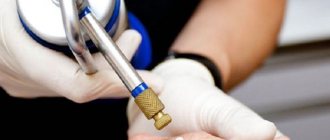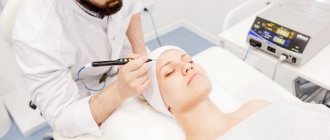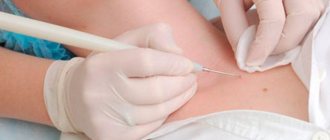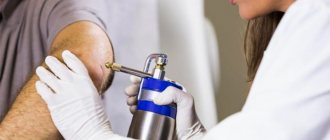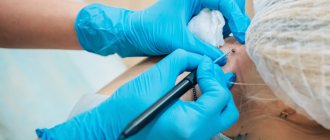Author
Kulova Zhanna Borisovna
Head of the Center for Cosmetology and Preventive Medicine
Cosmetologist
until January 31
We are giving away 1000 rubles for all services for a visit in January More details All promotions
Cryodestruction is a method of removing tumors on the skin, which is based on the use of liquid nitrogen. Often considered as a tool in aesthetic cosmetology and dermatology, allowing you to get rid of:
- warts;
- papillomas;
- condylomas;
- keratome;
- hemangiomas;
- unwanted moles (nevi).
This method is successfully used in other branches of medicine - gynecology, surgery, oncology. The method of cryodestruction successfully removes tonsils and treats cervical erosion. Using endoscopic methods, doctors have learned to use cryodestruction to combat tumors of internal organs.
Removal of tumors with liquid nitrogen: main advantages
The main advantage of this method is its low invasiveness. After the destruction of the tumor, a crust forms on the skin, under which the healing process is actively underway. Soon the crust falls off, leaving no trace. There is practically no bleeding or pain during this procedure; there is no need for special preparation or anesthesia.
The benefits of using liquid nitrogen include:
- rapidity;
- short recovery period;
- no need for special care of the treated skin area;
- affordable prices for cryodestruction procedures.
It is also important that various moles, papillomas or warts, regardless of their nature, can be treated equally effectively. Therefore, if you decide to remove a skin tumor by cryodestruction, you can count on a positive result after the first session.
How to treat a wound?
As a rule, doctors recommend various antibacterial drugs enriched with a vitamin complex. The choice of medications depends on the characteristics of the procedure performed. It is understood that the doctor will monitor the patient’s condition until complete recovery.
The wound heals due to the formation of a scab from anesthetized tissue. There is no need to use potent topical preparations if the process proceeds without any peculiarities or pathology.
If there is an accumulation of purulent formations, then additional care of the operated area will be required. If everything is in order, and a crust has formed on the wound, it is lubricated with a solution of peroxide and furatsilin, then, after it has softened, it is removed, treating the resulting funnel. All these procedures are carried out in a clinical setting by medical staff.
How is papillomas removed by cryodestruction?
A few seconds of exposure to liquid nitrogen is enough for the neoplasm to collapse
Using the example of papilloma, we will look at how the procedure for removing a tumor with liquid nitrogen is carried out. The process can be divided into the following stages:
1. Freezing papilloma. Using a special device or miniature applicator, the doctor applies liquid nitrogen with a temperature of –195.7 degrees Celsius to the tumor.
2. Necrosis of papilloma. Under the influence of liquid nitrogen, the pathological area turns pale, the patient begins to feel a slight tingling: this is the crystallization of the cytoplasm in the neoplasm cells, which damages their membranes. The time allotted for the procedure (from 5 to 30 seconds) is quite enough to cause irreparable damage to the papilloma.
3. Restoration of blood circulation. Within a few hours after the procedure, the area of skin where the papilloma was located turns red and swells.
4. Complete necrosis of papilloma. The process takes from 2 weeks to 2 months. From the neoplasm itself, only a crust remains, and healthy, smooth tissue forms under it.
5. Recovery. After a maximum of six months, there will be no traces left on the skin.
If the papilloma was large enough, the procedure may need to be repeated. In this case, only a doctor can give the exact timing of the final solution to the problem.
If after cryotherapy a bubble with liquid appears at the site of the tumor, it is not recommended to pierce it. It is better to treat the skin area with an antiseptic until this bubble disappears naturally, or consult a dermatologist for advice.
Is further treatment required after genital wart removal?
Yes, it is required. This is due to the prevention of recurrent manifestations of HPV (human papillomavirus). First of all, it is recommended to use drugs that stimulate the body's protective functions. This will help avoid relapse.
In addition, after removing condylomas, it is necessary to adhere to a certain regime and use special means:
• use immunostimulants;
• try to avoid chronic fatigue;
• avoid vitamin deficiency (take vitamin complexes, fresh fruits and vegetables);
• use local antiviral drugs (ointments, gels, sprays);
• beware of hypothermia;
• use condoms, since there are a number of HPV viruses with a high risk of complications - 35, 33, 31, 18 and 16;
• avoid emotional stress.
Indications and contraindications for cryodestruction
As a rule, patients decide to remove skin tumors wanting to get rid of cosmetic defects. First of all, it is recommended to remove moles and warts located in “unsuccessful” areas where they are regularly injured.
There are practically no contraindications to cryotherapy: it is recommended even for children, if necessary. But there are cases when it does not give the desired effect, for example, if the diameter of the tumor exceeds 4 mm.
It is better to refrain from cryodestruction during infectious and inflammatory processes until they are cured.
Make an appointment Do not self-medicate. Contact our specialists who will correctly diagnose and prescribe treatment.
Reasons for non-healing of a wound
In most cases, one of the most common problems is the non-healing of the operated surface for a long time. The reasons for this may be different.
After removal of a papilloma, compliance with postoperative care rules is critical.
Non-healing of the wound occurs when the area is wetted, the wound is sealed with an adhesive bandage, the use of corticosteroid ointments, premature application of cosmetics, shaving, and visiting a sauna.
Preventive measures for rapid wound healing: do not try to remove the crust yourself, do not visit solariums, baths and saunas for 3 months, do not expose the scar to the sun.
Take vitamins, follow a proper diet.
The main factors include the following:
- Ignoring or incomplete compliance the attending physician’s recommendations
- Sealing the wound with adhesive tape. This prevents the timely drying of tissues and the formation of a crust, which performs a protective function against infection.
- Wetting the area where the operation was performed. Until the wound becomes covered with a crust, the area cannot be washed. If such a situation could not be avoided, experts recommend letting the water dry on its own. It is forbidden to wipe this area, as any mechanical impact can lead to irritation.
- The use of creams that contain glucocorticoids. They help slow down the healing process.
- Applying the following products to the site of removal of the growth during the entire rehabilitation period : decorative cosmetics; alcohol lotions; foundation creams; hard scrubs; chemical substances.
- Using a pumice stone or sponge.
- Prolonged exposure to direct sunlight .
- Visiting a sauna, steam bath or solarium.
- Shaving the operated area of skin in the first few weeks after removal of the papilloma.
- Touching with hands. This also cannot be done, even if you first wash your hands with soap.
- An attempt to independently separate the formed protective crust.
It is important to remember that if the removal of the growth was carried out with a laser, then rapid rejection of papilloma tissue does not always occur. In this case, removing the scab yourself is also not recommended. This may only cause bleeding or scar formation.
Rashes on the chin in women often indicate pathology in the gynecological area.
In this case, you need the help of a gynecologist-endocrinologist. Long-term self-medication leads to chronicity of the process and complicates future therapy.
Dermatovenerologist, cosmetologist
Zhikhoreva Inna Viktorovna
6 years experience
Is it possible to remove papilloma yourself?
This is one of the most common questions asked by people with papillomavirus. Any doctor will tell you that this is impossible. It is also not possible to get rid of the growth using folk remedies. Attempts to separate the tumor at home can lead to severe injury to the eyelids, bleeding and other serious consequences.
Papillomaviruses have been studied for a long time. In total there are more than 600 strains. Some of them do not pose any danger, others cause various growths, including papillomas, warts, etc. Scientists have discovered a relationship between papillomaviruses and oncology. Thus, today the role of this virus in the formation of cervical and genital cancer in men and women has been proven. Some researchers say that papillomaviruses are capable of mutating into another virus inside the body of an infected person. So far this assumption has not been proven. In any case, papilloma should not be left untreated.
Treatment of papillomas on the eyelids
If suspicious formations appear on the skin of the eyelids, you should not put off visiting a doctor, because it is difficult to diagnose yourself, and correct diagnosis is the key to effective treatment.
After the appearance of papillomas on the eyelids, they slowly but steadily increase in size, so it would be optimal to treat them soon after detection, without waiting for their size and number to increase, as well as for the development of complications of the disease. Due to the anatomical proximity to the eyeball, papillomas on the eyelid are recommended to be removed.
Self-medication for eyelid papillomas is not acceptable and can lead to dire consequences. Attempts to cauterize papillomas with alcohol-containing solutions do not get rid of the formations, but can cause irritation of the mucous membrane of the eye. It is unacceptable to try to cauterize or trim the papilloma; this can cause inflammation or bleeding from the wound.
There is no effective drug treatment for eyelid papilloma; the only treatment is removal of the formations. Removal of papillomas is carried out on an outpatient basis in a one-day procedure, using local anesthesia.
Papillomas are removed by laser, electrocoagulation, cryodestruction (cauterization with liquid nitrogen) or surgery. Each of these methods has advantages and disadvantages, so the method of removing formations is determined by the attending ophthalmologist, based on the individual situation.
How much does radio wave wart removal cost?
| Consultation with a dermatologist on the day of wart removal using a dermatoscope up to 2 units. | 1200 RUR Sign up |
| Radio wave removal (large warts (plantar, palmar) - 20 min | 1500 RUR Sign up |
| Repeated radio wave removal (warts) – 20 min | 1400 RUR Sign up |
| Radio wave removal (small warts) for 1 unit. - 20 minutes | 800 RUR Sign up |
Features of the procedure
The process of excision of growths itself is quite fast - one tumor takes no more than 5 minutes. The papilloma is burned out layer by layer with a laser beam. Before starting the procedure, the specialist adjusts the equipment to the desired frequency, intensity and depth of impact - these parameters directly depend on the nature of the skin formations of a particular patient. In parallel with the laser beam, the cooling system of the installation affects the treated area, which protects against burns on adjacent areas of the skin.
A small wound remains at the site where the skin growth was located, which is immediately subject to disinfection. Additionally, healing and antiseptic agents can be applied.
If there are small numbers of single papillomas on the patient’s body, they are all removed in one session. If the skin lesions are extensive and there are numerous colonies of neoplasms, several procedures are necessary.
Treatment prices
The cost of surgical removal of papilloma on the eyelid depends on the number of elements removed and their location, ranging from 5,500 rubles. Various methods can be used, incl. laser (in this case the price will be from 5,000 rubles) - this issue is decided by the attending physician during the examination.
Histological examination (if necessary) is paid additionally (RUB 2,500).
By contacting the Moscow Eye Clinic, you will receive a quick and reliable diagnosis of papillomas on the eyelids and their effective treatment. All questions you are interested in can be asked to specialists by calling 8 and (499) 322-36-36 or via Skype consultation on the website.
Make an appointment
Other Possible Consequences
In addition to the fact that after removal of the papilloma, prolonged wound healing may occur, other possible negative consequences cannot be excluded. Pathological postoperative manifestations include the following:
- bleeding ;
- red spots on the skin
- general deterioration of health – dizziness, pressure surges, loss of appetite, drowsiness, increased body temperature;
- hyperemia and swelling at the site of removal of the growth;
- suppuration;
- itching and peeling;
- penetration of infection.
Also, if during the period of rehabilitation care the recommendations of a specialist were not followed, it is possible that a scar or scar may form at the site of the removed papilloma, which will be difficult to get rid of in the future.
Advantages of treatment of papillomas on the eyelids and prices at MGK
Removal of papilloma on the eyelids should only be performed by a specialist who has undergone professional training and has the appropriate skills. To avoid possible complications, this procedure should be entrusted to an experienced doctor. At the Moscow Eye Clinic you will be able to undergo all the necessary tests, based on the results of which the attending physician will recommend the most effective treatment methods in your case.
Removal of papillomas on the eyelids is performed on an outpatient basis under local anesthesia. During the procedure, sterile instruments and disposable consumables are used, which eliminates the risk of infectious complications.
Minimally invasive surgical interventions on the eyelids at the Moscow Eye Clinic are performed by ophthalmologist Zargaryan Asmik Erdzhanikovna, who performs all types of minor operations on the eyelids using a minimally invasive surgical technique using the SURGITRON radiosurgical device (USA). The surgical treatment of eyelid neoplasms at the clinic is also carried out by ophthalmologists Yulia Valerievna Yakovleva and.
Author:
Dagaev Adam Huseinovich 5/5 (1 rating)
Honey. portal:
Symptoms of vaginal papilloma
The virus infection scheme is as follows: first, the pathogen enters the dermis layer, affecting the membrane of healthy cells, then the infected DNA is introduced into the cell, after which the virus waits for favorable conditions for activation. In this situation, if the infected girl has a strong immune system, papillomas in the vagina may not form for a long time. In total, there are 3 stages of the disease. The first is characterized by the absence of pronounced symptoms. Depending on the general physical condition and the state of the immune system, this stage can occur over a long period of time, and in the absence of provoking causes, symptoms may not appear for several years. Despite this, the girl is already a carrier of the virus and can infect her sexual partner.
The second stage is characterized by changes in the mucous membrane of the genital organs. Neoplasms can be localized deep in the vagina, so it is not possible to identify them independently. Papillomas at the entrance to the vagina or on the labia can sometimes be detected by touch. Also, due to regular contact with clothing or during washing, they may bleed, which is a serious reason to consult a doctor.
- the appearance of severe pain during sexual intercourse;
- itching and burning in the intimate area;
- the appearance of purulent discharge.
Many girls are interested in what papillomas in the vagina look like. Unfortunately, you won’t be able to detect these growths on your own; to do this, you need to undergo a thorough diagnostic examination.
Contraindications for the procedure
Which patients should refuse laser removal of papillomas? Contraindications include pregnancy, active herpes infection, breastfeeding, and a history of diseases such as diabetes, HIV and AIDS.
If the patient has just returned from a vacation on the seaside, the specialist will recommend postponing the procedure 3-4 weeks later - a fresh tan is a relative contraindication.
More fresh and relevant information about health on our Telegram channel. Subscribe: https://t.me/foodandhealthru
We will be grateful if you use the buttons:
How to get rid of a scar
If an infection still gets into the wound after removing the papilloma and a scar forms, you should not delay treatment. It is always easier to get rid of fresh scars than old ones. Depending on the type of scar, its size and location, the doctor may prescribe physical therapy or cosmetology. If the scar is young and neat, anti-scar gels can easily deal with it.
Cosmetology
In a cosmetologist's office, you can remove a scar in several ways:
- cryodestruction;
- laser resurfacing;
- microdermabrasion;
- chemical peels;
- mesotherapy;
- complex methods combining several types of removal.
For mature hypertrophic and keloid scars, laser resurfacing methods, microdermabrasion, physiotherapy (electrophoresis/phonophoresis) with anti-scar agents, and surgical excision are suitable.
For atrophic, young hypertrophic and undeveloped keloid scars, cryodestruction and chemical peels are prescribed in combination with additional techniques - ozone therapy, hormone therapy, injection biopolymers, mesotherapy and physiotherapy. The application method for correcting scars with special cosmetic and medicinal products is also effective.
Normotrophic scars disappear on their own and do not require any intervention.
Physiotherapy
Unlike cosmetic procedures, physical therapy can be performed at home; you just need to purchase a portable device. Most often, against scars, in particular from papillomas, a course of electro- or phonophoresis is prescribed in combination with an anti-scar gel or solution.
Under the influence of physical factors, particles of the cosmetic product are transferred to deeper layers of the epidermis than would be possible with a simple application. They accumulate in the body in the form of a medicinal depot and begin to act gradually, due to which the effect of physiotherapy procedures lasts longer compared to cosmetic procedures (up to 36 hours). And due to the more gentle effect and work of medicines from the inside, the skin does not require a rehabilitation period (in cosmetology, the upper stratum corneum of the epidermis is inevitably injured).
Electrophoresis involves exposing the body to direct electric current. Differently charged electrodes are connected to the device, the ends of which are inserted into a gasket moistened with a medicinal solution. It is installed on the damaged area of the skin, after which a weak current charge is released.
During the procedure, the patient experiences a pleasant tingling sensation. A course of electrophoresis is prescribed for rehabilitation after colds, injuries, bruises, as a cosmetic against wrinkles and for smooth skin relief with scars.
Phonophoresis works using ultrasound. A thick layer of gel is applied to the scar. The head of the emitter is pressed tightly against the skin, to which an anti-scarring agent has already been applied, and is regularly added as it dries out during the procedure. For an effective phonophoresis procedure, it is necessary to ensure that there are no air obstacles between the skin and the emitter.
This method is also used against acne, facial wrinkles, treatment of joints and elimination of all types of scars.
Why are papillomas dangerous?
Typically, the appearance of skin formations is preceded by a situation that causes a decrease in immunity. This could be a previous cold, severe stress, hypothermia, exacerbation of chronic ailments and much more. In some cases, the “awakening” of the papilloma virus occurs during pregnancy.
Content:
- Why are papillomas dangerous?
- Benefits of laser papillomas removal
- How to prepare for the procedure
- Features of the procedure
- Rehabilitation after the procedure
- Contraindications for the procedure
It is almost impossible to determine the moment the virus enters the body - it can live quite peacefully in a person for decades and manifest itself only when unfavorable factors coincide, which have reduced the protective functions. Today, science knows about 130 types of HPV. The danger is that 10 of them have the ability to undergo malignant degeneration. That is, a small and unnoticeable growth on the skin can cause the development of a serious illness.
In some cases, after a certain period of time, papillomas disappear on their own - when the body’s defenses are restored. Most often, this phenomenon is observed in young and healthy women who encounter a problem during pregnancy - after childbirth, the growths begin to dry out and soon disappear. But you cannot let the course of the disease take its course - it is important to contact a specialist in a timely manner, who will select the most appropriate treatment method.
Attempts to eliminate tumors on your own can have negative consequences - from infection of the wound to the rapid spread of papillomas in healthy areas of the body. Improper treatment of HPV can cause relapse of the disease.
During laser removal, not only the body of the growth itself is destroyed, but also the pathological elements - that very thin stalk. Thanks to this, the risk of relapse is reduced by 85%.
